Cutch - 2012
'09 maps for:
Bea
--
Buck -- Caley --
Claws --
Conomo --
Hix --
Hudson 09 -- Isabel --
Katy -- L.R. --
Moffet --
Mr. Hannah --
Ozzie --
Penelope
--
Rafael
2010 maps for: Belle
-- Buck --
Gunny --
Hudson --
Mr. Hannah --
Neale --
North Fork Bob
--
Penelope --
Sanford
-- Sr. Bones --
Thatch
2011 maps:
Belle --
Buck --
Henrietta --
Katbird
-- North Fork Bob --
Pemi --
Saco --
Sanford --
Sr. Bones --
Snowy --
Thatch -- Tucker
2012 maps: Art -- Belle -- Bridger --
Chip -- Cutch --
Jill -- North Fork Bob --
Rammie -- Snowy --
Sr. Bones -- Thatch
2013 maps: Art --
Belle --
Bridger --
North Fork Bob --
Rammie --
Snowy --
Sr. Bones
Osprey
main page --
Migration
page --
Migration09 --
Migration10 --
Migration 11 --
Migration 12 --
Migration 13 -- Home
Page
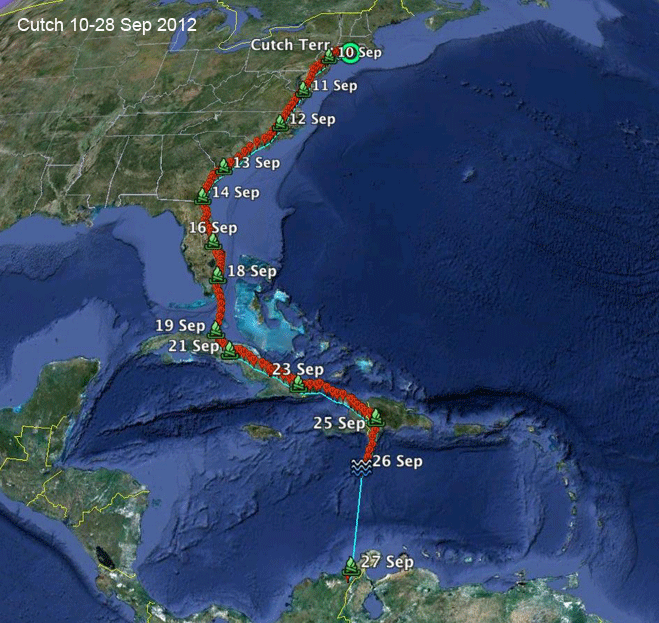 |
10-27 Sept 2012 -
Cutch is all business. He has had great weather
for migrating and made the most of the favorable
tail winds. His biggest move was on the 13th,
when he covered 286 miles (460 km) from North to
South Carolina. Cutch was our second bird across the Caribbean, just a day behind our New Hampshire juvenile, Jill. Sadly, the day after he made the crossing, his transmitter stopped moving, which means he either lost it (unlikely), or he died. As expected, we discovered that Cutch did indeed die. The rather remarkable details are revealed at the end of this page. Scroll down for all his maps, or... Skip to the start of migration. |
 |
31 July-4 Aug 2012 -
Cutch spent the first 5 days after we trapped
him wandering around the North Fork. On the 4th
he flew across Long Island Sound. Our last
locations for him show that he's working his way
up the Connecticut River. This looks to me like a young male just back on the breeding grounds after his 18 months down south. And maybe these weren't even his breeding grounds. |
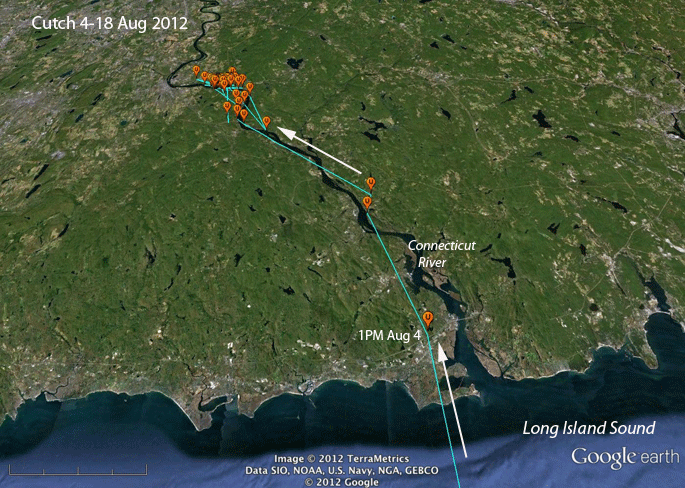 |
4-18 Aug 2012 -
Cutch has settled down for a spell on the
Connecticut River near Middletown, CT. And if anyone's curious about why Cutch's little balloon now has a 'U,' blame it on "Chip" up in New Hampshire. I didn't want two 'U' symbols--so just look at Cutch's balloons sideways ;-). |
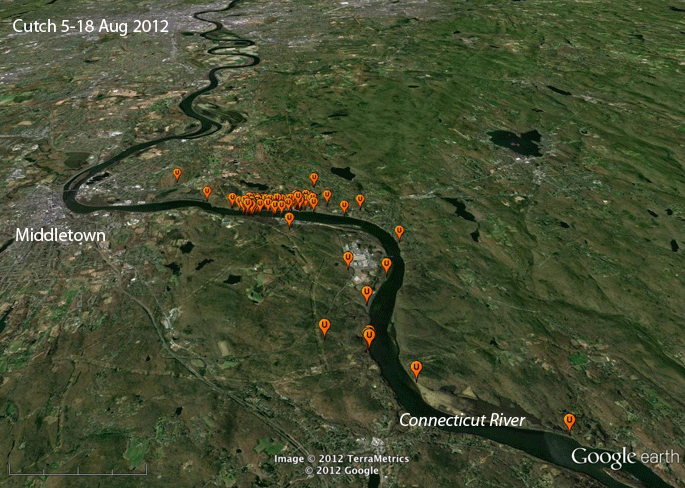 |
5-18 Aug 2012 - Cutch was really focused on one small stretch of the river for 2 weeks. |
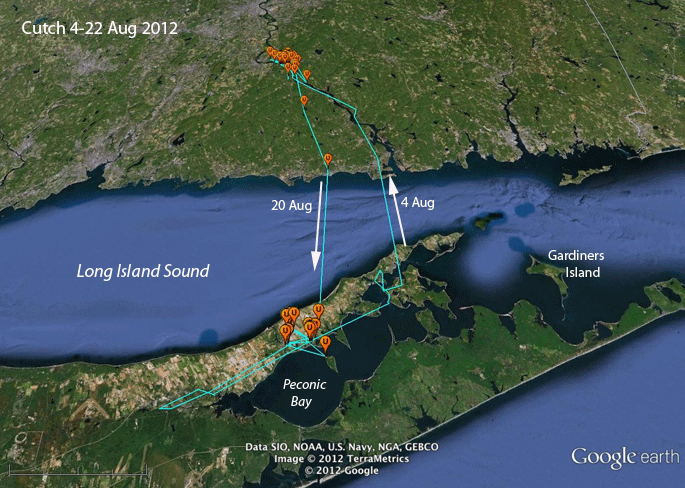 |
4-22 Aug 2012 - Cutch is back on Long Island, which makes me think that this was where he was born. |
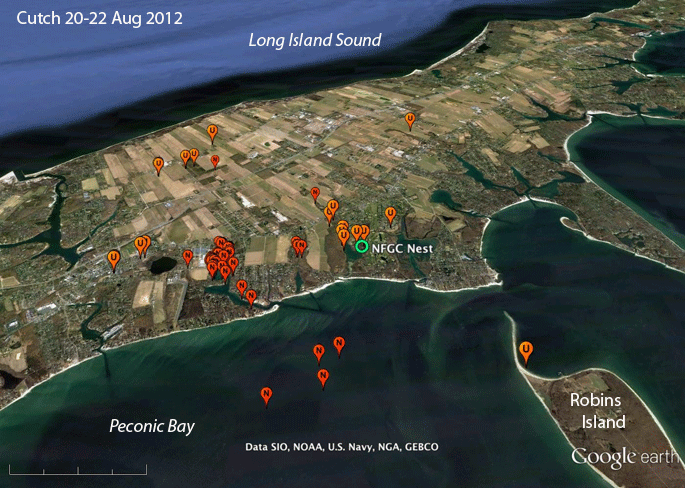 |
20-22 Aug 2012 -
And now I'm thinking he's actually a young from
the North Fork Golf Club nest on Downs Creek,
probably born there two years ago. This behavior
looks like what we saw Buck do down in South
Carolina. When Buck finally (after 109 days and
over 8,900 miles of wandering around the eastern
U.S.) got back to his natal territory, he often
foraged close to his old nest. The orange/N balloons are North Fork Bob's locations. |
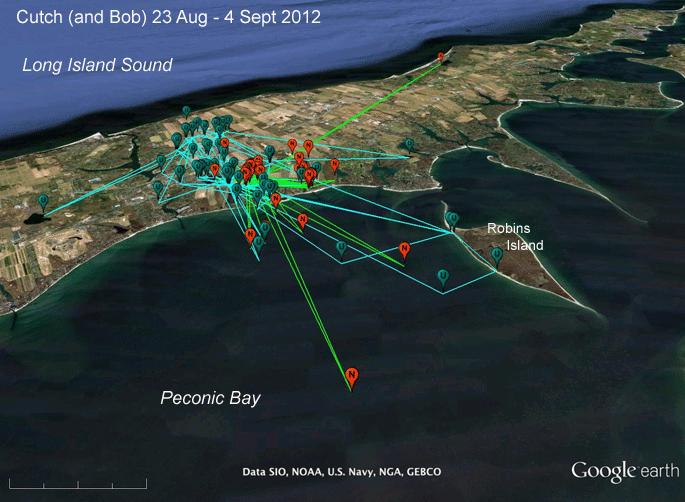 |
23 Aug-4 Sept 2012 - Cutch and North Fork Bob are doing a lot of fishing out in Peconic Bay. |
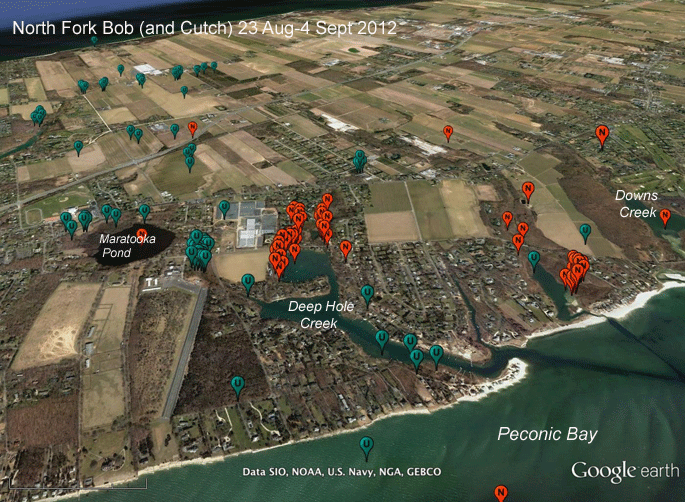 |
23 Aug-4 Sept 2012 -
Cutch and North Fork Bob were both caught with
their talons in the cookie jar, as it were,
trying to take a fish from under our noose
carpet set on the nest at the North Fork Golf
Course nest on Downs Creek. One thing that caught my attention in this map is the series of GPS locations in the north of this map sort of out in the middle of nowhere, Osprey-wise. What's that all about? No ponds nearby. When you zoom in, you see that there's a power line going through there. Cutch seems to like the view from the towers on that line. |
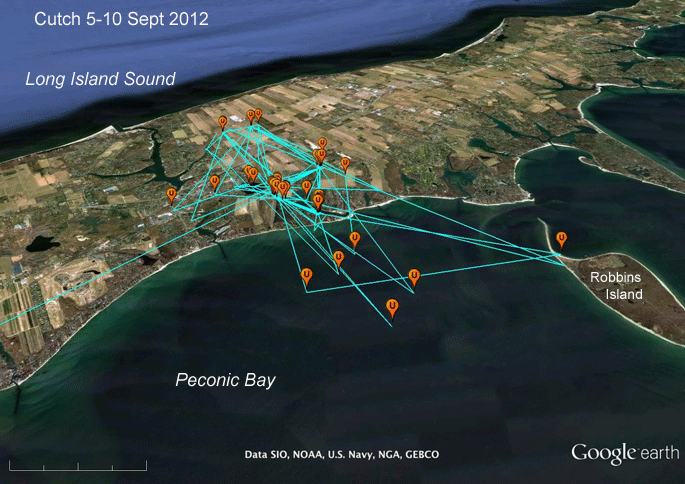 |
5-10 Sept 2012 - Cutch is hanging around, fishing a lot in Peconic Bay, getting ready to head south. |
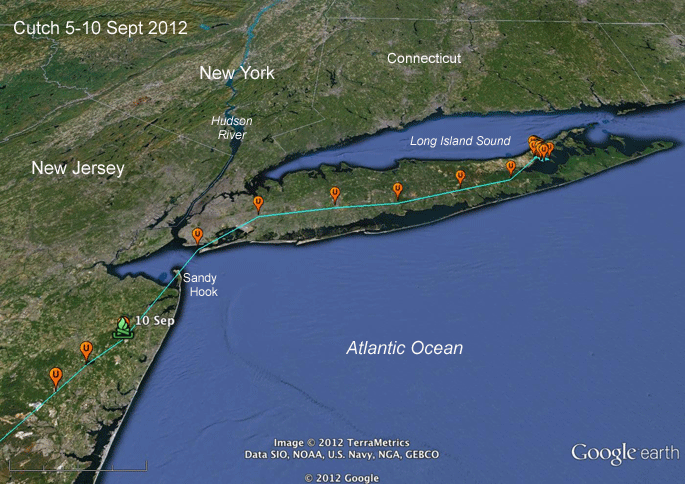 |
10 Sept 2012 -
He's off! I'm pretty sure he's a 3-yr old, so
this will be his second trip south (if I'm
right). In any case, he knows where he's going.
We get to follow him down to someplace in South
America, most likely. He spent his first night just west of Asbury Park. |
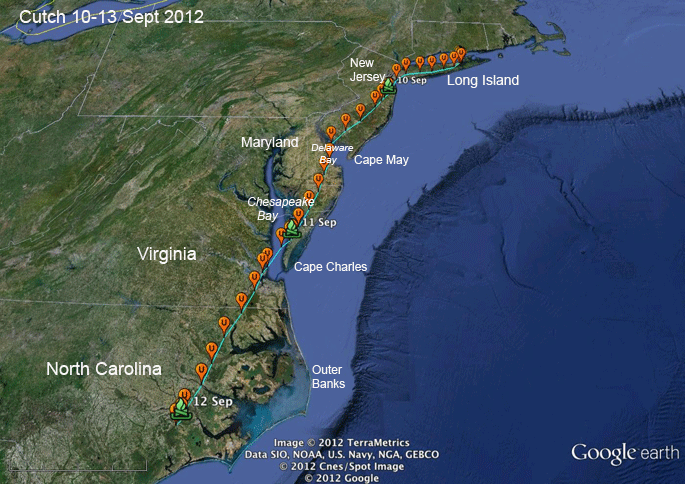 |
10-12 Sept 2012 -
Cutch covered 509 miles (820 km) in three days,
averaging about 170 miles/day, which is about
average for a migrating Osprey. He crossed Delaware Bay west of the Cape May Hawk Count, which may make up for all the times Thatch is getting counted as he yings around Cape May ;-). |
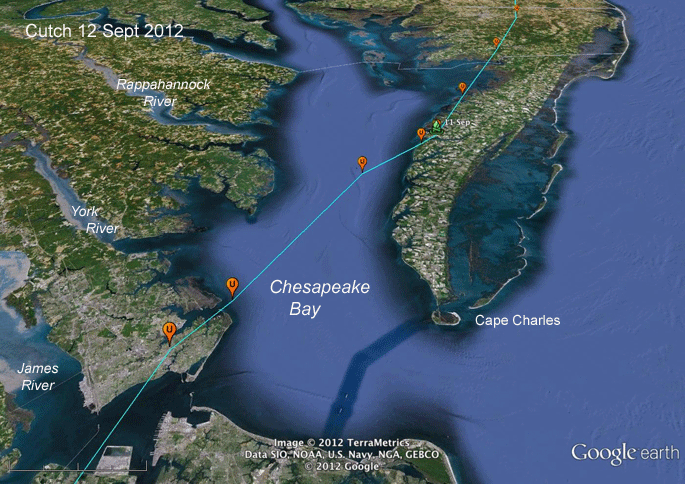 |
12 Sept 2012 - Cutch crossed Chesapeake Bay in a little over an hour. Remember that each point is 1 hour after the previous one. The long stretch across the Bay is 25 miles, and that's smack on the average for an Osprey on migration. The next two points are only 5 miles apart, and no Osprey flies 5 miles an hour, so we can infer that he spent some time fishing once he hit the west side of the Bay, between the York and James Rivers. |
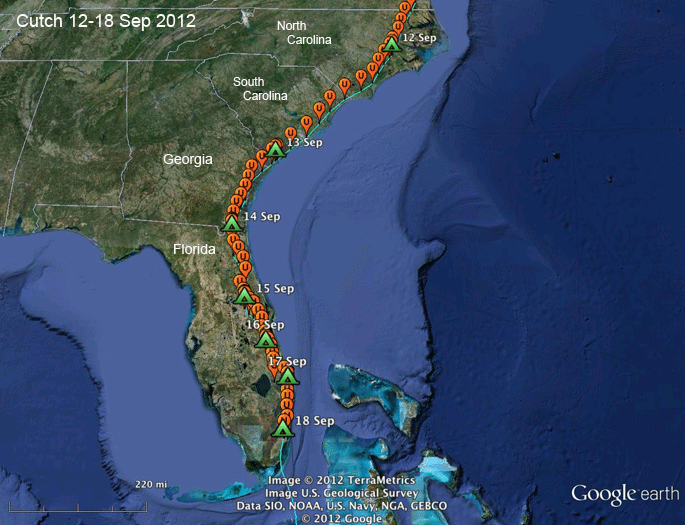 |
12-18 Sept 2012 - Cutch covered some ground on the 13th and 14th, but then slowed down a bit as he moseyed his way south through Florida. |
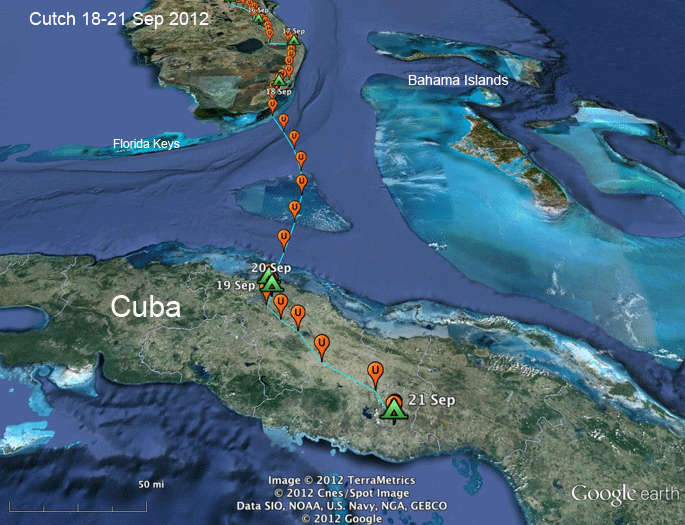 |
18-21 Sept 2012 - Cutch got a late start heading out over the Florida Strait, leaving the Keys behind about 1PM. About 6.5 hours and 160 miles later he made landfall on Cuba's north shore. He averaged 24 MPH over the water, which is pretty typical. |
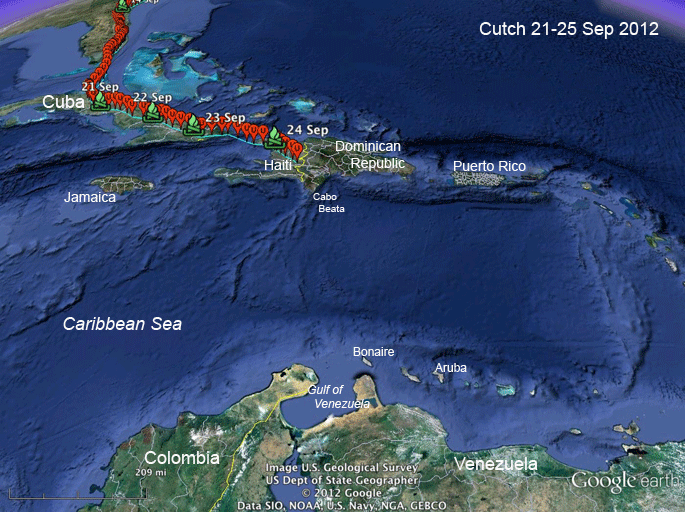 |
21-25 Sept 2012 - Cutch made it through Cuba without stopping at a fish farm, which is always good news. That's the first of the threats faced by southbound Ospreys through the Caribbean. Next he has to avoid Dominican farmers who think he might take their chickens, and then he has to dodge any passing hurricanes or other big weather crossing from Hispaniola to South America. It looks like he's headed straight to Cabo Beata (ever want to see a lot of Ospreys some fall, go down there!), which would keep him out of the Dominican danger zone. |
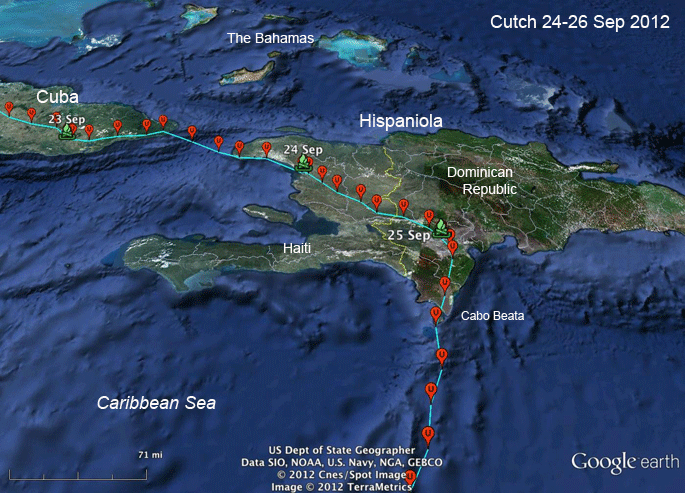 |
24-26 Sept 2012 -
Cutch buzzed right through Hispaniola--again the
way we like it. And he headed out over the
Caribbean into good weather. So far this has
been a really good season for us. We have three more birds coming right behind Cutch and it looks like the weather will be good for them, too, if they get a move on. On the 26th he started out around 9:30 AM and flew about 8 miles before he found a small lake. It seems like he spent a half hour there--maybe grabbing one for the road--before kicking into full migration mode. |
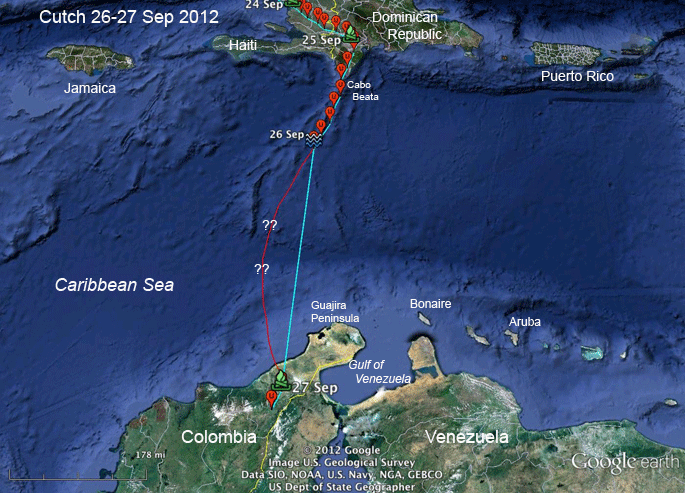 |
26-27 Sept 2012 -
Cutch left Cabo Beata behind around 12:30 and
flew 115 miles in the next five hours, averaging
a pretty typical 23 mph. As usual, we don't know exactly what path he took over the Caribbean between the last GPS fix on 26 Sep and his arrival in Colombia--it certainly wasn't the dead straight line indicated here, but it probably was more of a gentle arc (the red track) southwest and then southeast before making landfall in Colombia southwest of the Guajira Peninsula. (Anyone who's been following these maps for a few years is bound to get the Trivial Pursuits geography question on what's South America's northernmost point of land!) Cutch flew at least 300 more miles from the last fix on the 26th at 9 PM before getting to Colombia. Assuming he kept flying the same speed, he would have arrived in S.A. about 13 hours later. Given that he would have taken a slightly longer route, he probably got to Colombia around 10 AM. (Hard as it is to believe, the red track is only about 20 miles longer than the straight blue track connecting the last fix for the 26th and his roost on the 27th!) |
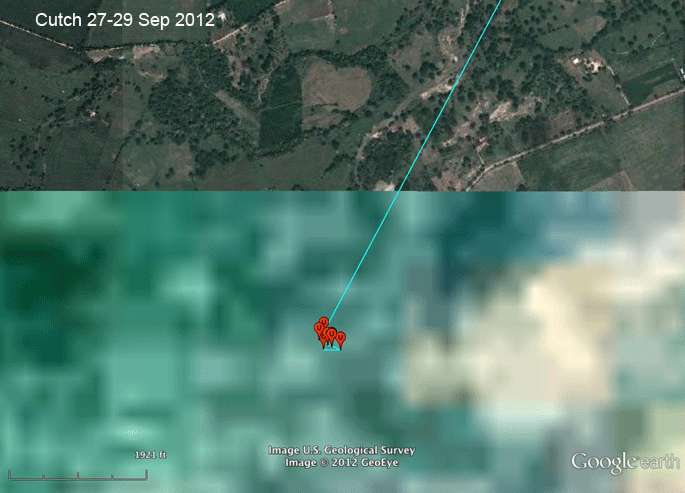 |
27-29 Sept 2012 -
Cutch's signals stopped moving in Colombia.
Frustratingly, the last signals are in a region
for which Google Earth has a very low resolution
image, so we can't get much of a clue as to what
happened to him. Is he by the side of the road
(that would be too coincidental, given that this
transmitter was taken off Tucker when he flew
into a bus up in Long Island last summer), or at
a fish farm, or just a farmyard with a small
pond, like Meadow's last location? We can see
that the area is under pretty intensive
agriculture, so the most likely cause of death
would be some interaction with one of our
conspecifics--i.e. a human. I hate to lose any bird, but Cutch's return was going to be interesting, as he would have been just getting ready to find a mate, assuming my speculation that he was a 3-yr old on his first return to this natal territory this spring. This period in the lives of Ospreys is really poorly understood and one of the reasons we're tagging juveniles. North Fork Bob seems to be in this class of young birds trying to find a breeding opportunity. |
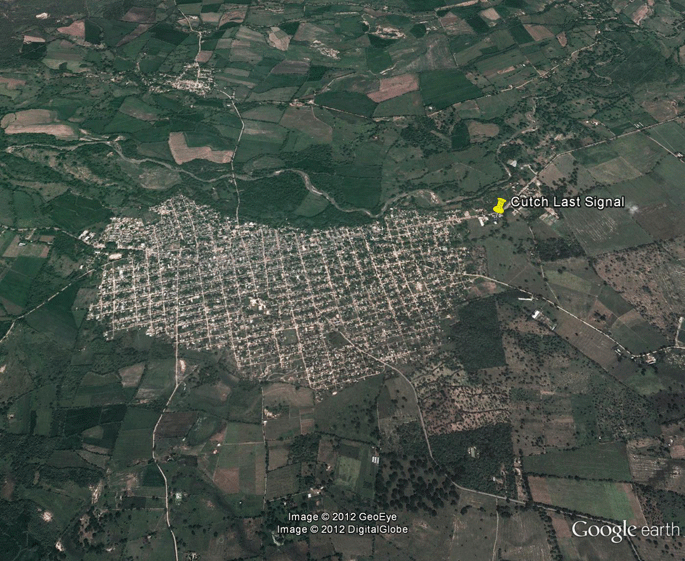 |
29 Sept 2012 - One mystery solved, one generated. The new mystery (of interest only to me) is why my laptop won't download the Google Earth photography that includes the town of El Barrial, Colombia--Cutch's final resting place--while my desktop will? Much more importantly, the mystery solved [or so we thought! Keep scrolling...] is what happened to Cutch. All the evidence and past experience pointed to his having been shot. The transmitter is now at the spot indicated in this aerial photo. Zooming in... |
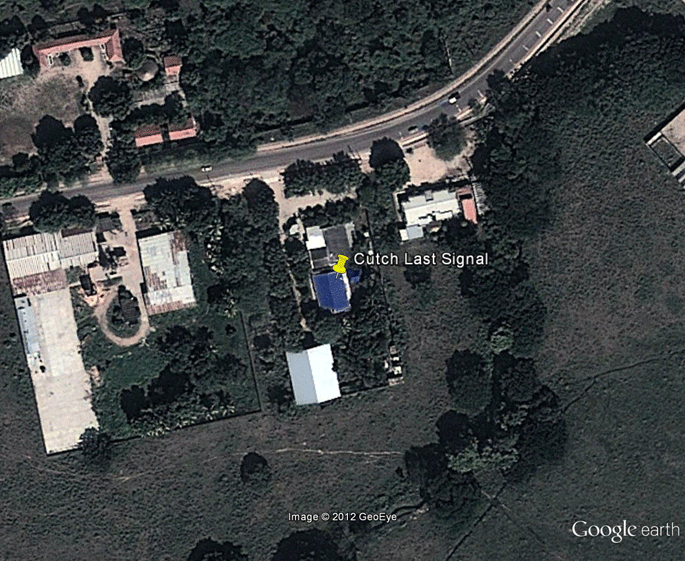 |
... we see that the
transmitter is now in this house at the
outskirts of El Barrial. As of about 3 hours ago, I was still convinced that Cutch had been shot. But, the plot has another twist, of course... |
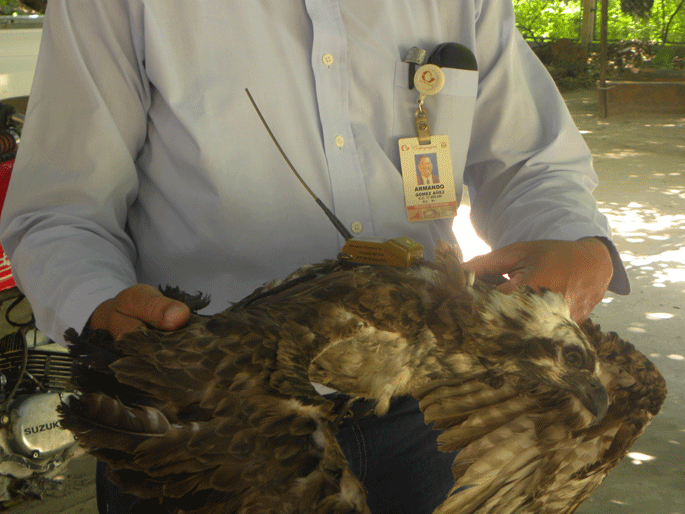 |
Less than 2 hours after
posting an email to the Neotropical Raptor
Group, I received several emails with not only
offers to help, but also an alternative solution
to the mystery, including the forensic
post-mortem photos. The first story was that poor Cutch
got tangled in a fishing net and drowned. In the
next batch of emails the story changed to he was
diving into the water and was impaled on a stick
and bled to death. I must say the story of the fishing net didn't really fit the picture. This isn't a bird that spent time struggling in a net underwater. I'm hoping to get more details on the impaling story. The good news that the transmitter is safely in the hands of the local authorities and we'll get it back. [Once I convince them that they can't use it to study flamingos!] Hopefully the next bird to wear it will have better luck than Tucker or Cutch! Bummer. (What did we do without the Internet? We did a lot of stuff, but we certainly didn't have a picture of a bird lost in the northeastern corner of Colombia 2 hours after asking if anyone could help me recover the transmitter!) |
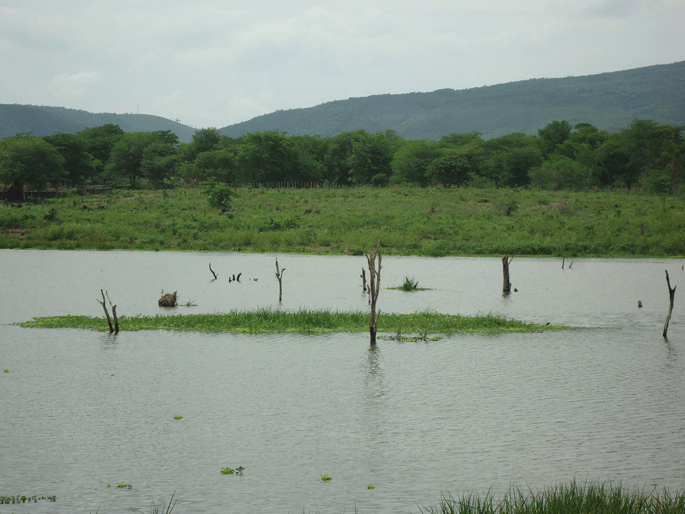 |
I confess that the impaling story sounded a bit, well, fishy. But I'm now a believer. Here's the small pond where Cutch died on the "Chivo Mono" finca (ranch). When the pond was made, lots of trees died, some of which still protrude above the water. Clearly there are plenty more snags below the water surface, making this a dangerous place to hit the water at high speed, the way an Osprey does. |
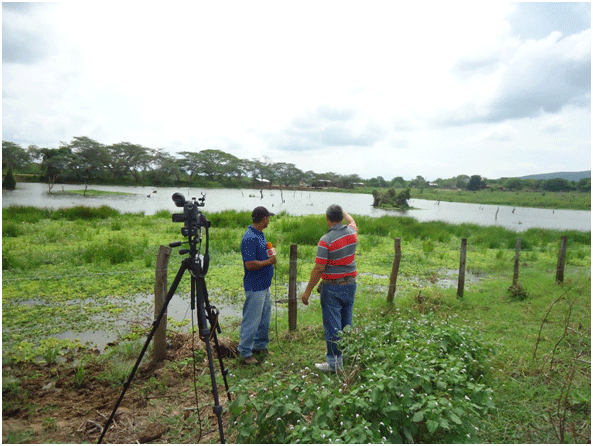 |
Another view of the pond with a TV crew working on the story of Cutch's demise, which aired on national TV! |
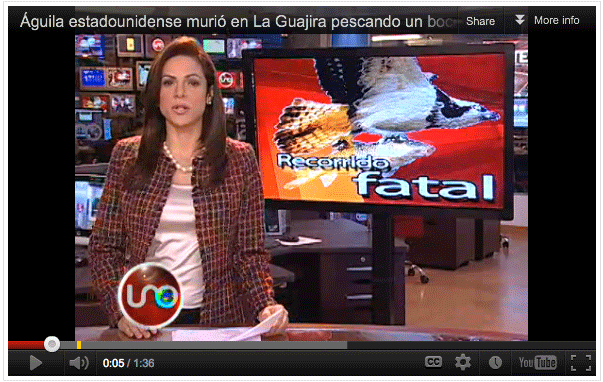 |
The caption reads " 'Unitedstatesian' eagle died in Guajira fishing..." Below this, the story reports that the death was originally thought to be an assassination but it turned out to be an "accidental suicide." Here's a link to the story on Uno: http://bit.ly/X0KeT6 (not sure how long it will stay up.) |